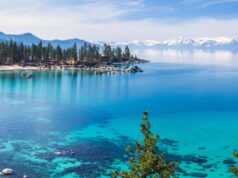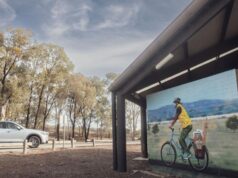
It’s winter in Alberta, in the heart of Canada’s Rocky Mountains, and a frozen waterfall is suspended over a limestone chasm in Johnston Canyon. The double meaning of the word “frozen” has never been so potently embodied as it is right now. But the blue-tinged ice is actually a translucent curtain, with running water gushing behind, like a detuned television trying to pick up a signal, with white noise to match.
The contrast of movement behind the motionless ice is spellbinding. At a pool at the bottom, the flowing water bubbles so vigorously you could almost mistake it for a hot tub, if it wasn’t so obviously the complete opposite. How a flowing waterfall freezes mid-stream I can only put down to wizardry, or possibly the more complex thermodynamic explanation given by our Discover Banff Tours guide, Tim, which I would have jotted down had my hands not been inside two pairs of gloves within the pockets of a goose-down jacket. When it’s minus 20C, the supernatural will suffice.
I’m playing a constant cat and mouse game with the cold during this road trip through the Canadian Rocky Mountain Parks UNESCO World Heritage site. It’s a wonderland of mountains, glaciers, lakes, canyons, and yes, even hot springs. Under its winter coat the landscape is so transfixing it’s hard to believe this is the off season.
Summer here is so popular no one bothers promoting it. But far fewer make the journey in winter. Fewer still consider driving, perhaps put off by the thought of icy roads, snow storms or breakdowns far from civilisation. But the hire car I pick up in Calgary looks sturdy enough, fitted with snow tyres (confidence boosting), a small shovel (confidence denting) and most importantly a good heater.


